Manga, Anime and Video Games: Between Adaptation, Transmedia Extension and Reverse Remediation
By Stefan Werning
Introduction
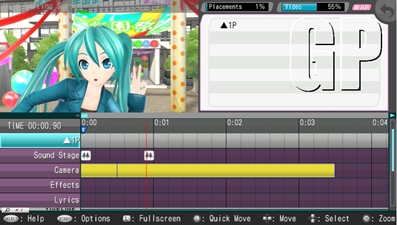
Figure 1
For the last few years, textual relations between manga/anime and video games have become increasingly complex, which suggests that both media formats share some fundamental conceptual elements. For instance, fan fiction and cosplaying1 represent fan activities that extend the narrative worlds of anime franchises but also include elements of performativity and games, drawing on characters from both spheres and occasionally even producing mash-up narratives. Both media formats are characterized by a strong focus on fictional characters as autonomous entities in contrast to the idolization of actors as role models in Western media contexts.2 Therefore, media phenomena like Hatsune Miku (Figure 1) combine anime-specific traits and appearance with video game adaptations that associate the character with rhythm-based gameplay mechanics and related media elements such as live concert performances.3
The concept of adaptation—the process of change—is so associated with art and narrative practice for those of us in the humanities that its biological application recedes from view. Games, however, as rule-bound, organized forms of play, reside at the intersection of nature and nurture, of biology and culture. Because games are representations of both the material world and our agency within it, adaptation emerges as a central feature of game design—and game play. Said another way: games are born out of adaptation, they live in the adaptations of those who play them, and they perish when they no longer prove adaptable.
This essay proposes to reassess this relationship by systematically analyzing the functions of (video) game references in popular recent manga and anime series. The earliest manga/anime that were adapted into globally popular video games date back to the late 1980s; for instance, the influential manga/anime Akira, which was instrumental in making the media format popular in the United States and Europe, was adapted into a game for the Nintendo Entertainment System in 1988.4
As Dani Cavallaro indicates, manga and anime based on digital games appeared much later;5 for example, series like Fate Stay/Night (2006) have been developed as adaptations of existing visual novels, a game genre that combines detailed textual descriptions, dialogues and illustrations similar to a comic book but adds multiple-choice decisions and other nonlinear elements that lead to branching narrative paths. The examples analyzed below, however, exhibit less direct and more complex textual relations; for instance, the entire narrative world of Sword Art Online (2009-2014), Accel World (2012) and Btooom! (2012) is constructed around a fictional video game. This phenomenon can be partially explained in the context of films referencing (digital) games as plot elements or even as narrative structures. In the 1980s and 90s, several movies such as Tron (Steven Lisberger, 1982), War Games (John Badham, 1983), Running Man (Paul Michael Glaser, 1987) and Jumanji (Joe Johnston, 1995) referenced (digital) games and game shows, often as a focal point for implied social criticism or as a plausible “playing field” to showcase newly available computer-generated visual effects. Moreover, at the same time, movie adaptations of popular game franchises such as Super Mario Bros. (Rocky Morton & Annabel Jankel, 1993) or Street Fighter (Steven E. de Souza, 1994, Figure 2) were first produced for an international audience. Even though critics dismissed these movies, and although they yielded only limited box office success,6 they nourished industry and audience expectations that computer games would soon marginalize the role of movies as an entertainment medium. Given that filmmakers in the early 1980s such as Tron director Steven Lisberger already surmised a “danger that movies are going to end up being expensive commercials for videogames,”7 however, these sentiments appear all the more exaggerated in retrospect.
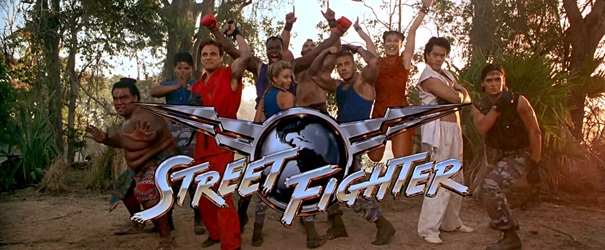
Figure 2
More appropriately, as computer and video games pushed towards the media mainstream during that time, all these movies can be understood as what William Uricchio sees as attempts to define the “media identity”8 of film, both by adopting the settings and themes of video games and, at the same time, by surpassing the visual spectacle they offered. The inverse case, that of the emergence of interactive movies imitating and simultaneously “surpassing” films,9 thereby points to the fact that the film and video game industries became more and more closely interrelated during the 1990s. Notable manifestations of this convergence were the PlayStation console and its attempt to offer movie-like experiences, CD-ROM-based games that often implemented full-motion video (FMV) sequences shot in a studio and a growing number of video game adaptations. Later films referencing video games such as Scott Pilgrim vs. the World (Edgar Wright 2010) or Wreck-It Ralph (Rich Moore 2012) shifted that focus towards media reflexivity, drawing on the extensive and increasingly consistent game knowledge of their target audiences. This essay therefore attempts to systematize how the recently increasing narrative as well as aesthetic interplay between manga, anime and digital games and, even more importantly, their mutual narrativization amplifies and extends this transmedia relationship.
Reverse remediation
First and foremost, game-related manga/anime can be understood as a prominent form of reverse remediation;10 in other words, they function as a strategic attempt to reinvent an established media format by adopting and “simulat[ing]” elements of “new media” genres such as video games. A rather conspicuous example is the use of game-based user interfaces as an aesthetic element in recently popular manga/anime such as Sword Art Online (2012-) or Accel World (2010-). Sword Art Online features several user interface (UI) tropes (Figure 3) from massively multiplayer online role-playing games (MMORPGs) such as a tabular inventory, textual descriptions of “objects” in the game world (including systemic properties such as “indestructible”) and color-coded markers to indicate players, who recently or even repeatedly killed or robbed other players.11
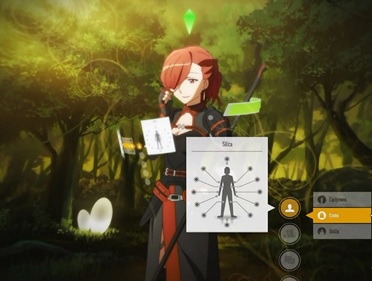
Figure 3
These audiovisual cues are not simply a product of aesthetic cross-pollination, but they also use viewers’ diverging knowledge of game rules and UI conventions as a non-verbal way to foreshadow plot twists and to strategically alter viewers’ hermeneutic disposition. For instance, the major plot twist in the first season, the fact that guild leader Heathcliff is in fact the avatar of the game’s creator and main villain, is communicated first by the UI message box that pops up when a player attacks Heathcliff, stating that “he” is in fact an “immortal object” (a player character with administrator rights). The UI references, moreover, serve as a means of inclusion and exclusion because they invoke a sense of community between viewers who understand the UI “syntax.” Thus, they affect online fan discourse through “shared expert knowledge” and allow for fans to identify with the franchise. Third, Sword Art Online “simulates” an underlying rule system that is reflected by and can be reconstructed through the UI. With each episode, viewers use the newly introduced or modified UI elements to iteratively refine their mental model of the rule system, to expand it by inventing their own rules and to discuss potential alternatives. Therefore, the UI elements both encourage and channel the creation of user-generated content,12 effectively turning Sword Art Online and related series into sustainable transmedia franchises. Still, this narrative strategy has been only superficially explored as of yet.
Transmedia extension
Video games are often used as an economically motivated form of transmedia extension13 for manga/anime franchises. Many recent shōnen anime (franchises aimed at a male audience aged thirteen and above) are planned for only one or two seasons (totaling approximately twelve or twenty-four episodes) in order to gauge viewer interest. If the series proves popular, video games are produced as a comparatively cost-effective way of keeping the franchise “active” without having to follow up on the original anime series. This release strategy represents a tried-and-tested transmedia “choreography.” First, compared to other, more or less effective tie-ins between media formats in franchises such as The Matrix (1999-2003),14 the relation between anime series and follow-up games is much more condensed; more specifically, it usually does not involve additional media formats other than promotional images distributed via fan magazines and websites and, in some cases, the original light novels.15 Second, this “choreography” is not specifically tailored to the franchise at hand, but it can be understood as an “industry standard” or at least as a stable formula for this particular shōnen anime sub-genre.
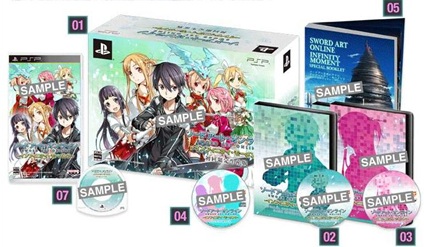
Figure 4
Moreover, the special editions of the video games (Figure 4) usually contain a single original video animation (OVA); these special episodes “remind” players of the anime material and smoothen the transition back to the often graphically inferior video games, which are usually released for portable platforms such as the PlayStation Portable and PlayStation Vita or the Nintendo 3DS. These single episodes usually offer “fan service”16 but also create a more relaxed setting that allows for the recapitulation of past events. As such, they perform similar functions as “walkthrough” videos for digital games; as Clive Thompson argues, ”walkthrough” videos can be interpreted in terms of “travel literature,”17 an interpretation that reframes the game as a journey by narrativizing and “embellishing’” the experience but also completes the player’s understanding of the game as a system.
Even though many of the anime series represent adaptations of light novels, the games usually do not cover the “canonic” stories from the novels but rather pick up loose ends and elaborate on the characters, often in unusual ways, thereby adding to the “multiplicity”18 of the franchise. Most notably, the games take over the simulated rule system and “transcode”19 it into an actual working and (more or less) balanced rule ecology. Additional paratextual materials such as data books for prominent franchises such as Naruto or Bleach bridge the gap between both media formats; they already “quantify”20 the characters and their powers, and these data are again at least used as a reference point for the combat mechanics in the games. This approach could be summarized as a form of “second-order remediation” because the “new medium” of the video game derives its rule system from a novel/manga/animated series that already draws on video games, such as in terms of narrative logic and character constellations.
This textual relation can again be (and is already being) reversed by franchises such as Hyperdimension Neptunia, which started out from a relatively generic video game that featured extravagant characters that have further unfolded in a corresponding manga and anime. The franchise turns the meta-narrative element of the “console wars”21 between the seventh-generation video game consoles into its main narrative premise as the female characters represent moé-anthropomorphisms of video game consoles such as the Xbox 360 or the PlayStation 3; thus, it blurs the epistemic boundary between the anime diegesis and fan discourse in an attempt to create immersion through hypermediacy. While an exploration of this subgenre goes beyond the scope of this essay, it exemplifies that the textual relations and their potential transformations are being strategically explored for economic reasons, fueled by the increasing convergence of comic book publishers, video game companies and anime production studios. Cavallaro, for instance, points out that anime has been aesthetically influential since the early days of video game design because many game designers of this era were trained as manga artists in design colleges rather than as computer programmers.22
Adaptation and narrative functions
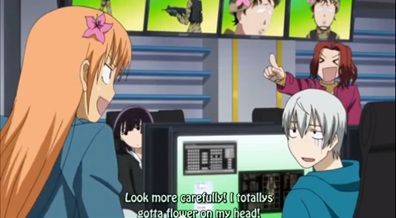
Figure 5
In addition to this aesthetic influence, game elements are being used in manga/anime for various narrative purposes, particularly because they can non-verbally convey sufficiently unambiguous information by drawing on the collective knowledge of game rules and tropes shared by viewers. Some rather superficial uses of videogame references might merely provide comic relief and offer a change of pace (or draw out a story arc). The popular manga series Beelzebub (2009-) includes several more or less elaborate game references, which all have little or no relevance for the respective main plot. The manga itself and the corresponding anime share structural elements with the video game beat’em up/brawler genre23 and, with regard to the high school setting and the premise of competing student gangs, are particularly reminiscent of the iconic brawler game River City Ransom developed by Technōs Japan in 1989. One expanded game reference in the Beelzebub manga (chapters 97-102) includes several protagonists playing a multiplayer third-person shooter (Figure 5) called The End of War 4.24 Even though it superficially ties into the main plot, the online match primarily serves to juxtapose the (by then) familiar characters with their – often radically different – in-game alter egos. The characters’ diverging experience with video games is extremely exaggerated and reflected in their avatars’ physical appearance. Therefore, the humor essentially draws on the viewers’/players’ knowledge of avatar customization to be effective.
Second, adapting game elements can be an opportunity to renegotiate established gender and identity categories. For example, the Taiwanese manhua25 ½ Prince (2007-) for the most part takes place within a fictional game world but characteristically plays on the shifting relationships between the characters’ real-world identities and their virtual counterparts. The protagonist, a nineteen-year-old-girl, is the only character whose in-game avatar does not reflect her actual sex, and, in the game, she plays the part of the larger-than-life hero that readers are familiar with from many regular shōnen manga/anime franchises. The latter example also hints at a self-referential and media-reflexive quality of game references in manga and anime formats. Because of the sheer quantity of manga and anime production and the increasing complexity and intensity of fan discourse, these media formats have produced an “inventory” of very stable and well-known tropes.26 From that angle, the use of video game references facilitates re-thinking these plot and character stereotypes within manga and anime such as ½ Prince through the juxtaposition of the narrative layers of the game world and “real life.”
Apart from that, drawing on player knowledge of games allows for conveying social criticism in an at least partially non-verbal and, therefore, more effective way. For example, Btooom! (2009-/2012) tells the story of a professional first-person shooter player, who is forced into a game of survival on a remote island that mimics the mechanics (and, thus, the rationales) of his intradiegetic game of choice, Btooom. The participants have been “nominated” because they made a mistake that others believe should have been “punished.” The same fictional game company that created the Btooom video game, Tyrannos Japan, then kidnaps the participants and hosts the Battle Royale-inspired setting for paid viewers. Even though the plot itself appears rather ludicrous, the topics touched upon such as the differentiation between games and “real life,” the problematic momentum of people acting out a role in a game (which calls to mind the Milgram experiment27) and the ethical aspects of real-life game show formats are quite relevant and can be approached differently (and in some cases more convincingly) using the narrative “proxy” of the fictional game Btooom.
Yet another, even more recent narrative strategy of using game references across franchises can be understood with through Mikhail Bakthtin’s concept of as dialogicity. The success of several recent manga/anime led to the creation of thematically related franchises, variations on the same theme or even “counter-texts.” For example, viewers usually interpret Log Horizon (2013-) directly with reference to and distinguished from Sword Art Online28 as the most prominent game-related manga/anime. A more specific example is The World God only Knows (2008-), a manga referencing the genre of dating games, which is often formally associated with the aforementioned visual novels. The narrativization therefore adds to the increasing acceptance of dating games as an integral aspect of Japanese culture. Its protagonist, Keima Katsuragi (Figure 6), is described as being able to beat any dating game, and the story draws its momentum mostly from him applying his strategies from the game to the real world in a humorously exaggerated manner. The game references are used to turn traditional assessments and causalities upside down; for example, Katsuragi, who serves as the focal point for reader identification, describes girls that do not conform to his game-based expectations as “imperfections.”29 Based on this premise, the manga WataMote30 can be understood as a “counter-text” because it transfers the same narrative frame to a female protagonist. It takes a more serious tone and describes how the fifteen-year-old girl Tomoko Kuroki “discovers” that life differs considerably from the scenarios of otome games (dating simulations geared toward female players) and adapts to these experiences over time. In both manga, the games and the readers’ implied experience with similar games are used as metaphors for the more general problem of fitting into a social environment and understanding the “rules” of everyday life based on the familiar (and more predictable) rules of the games the characters play.
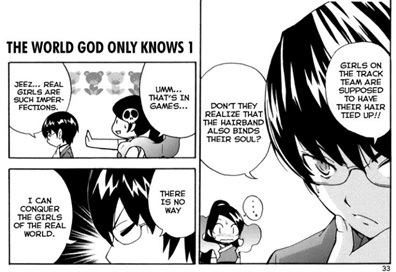
Figure 6
Moving on from the interpretation to the production side, game references can be understood as a “storytelling engine,”31 as they provide a set of interlocking plot points and “rules” that can be used to “generate” new, logically consistent stories set in the same narrative universe. The early episodes of Log Horizon (2013-) are rather procedural and unfold small storylines based on fundamental MMORPG game mechanics such as player-killing or team tactics. Even though the anime is clearly geared towards gamers, most early episodes start by recapitulating the corresponding game rules. Thus, from a production perspective, a strategic extrapolation of the rule system outlines potential forms of narrative progression that can be “played out” using the characters already introduced or by introducing new characters. Particularly, rule inconsistencies and exploits or exceptions provide ample narrative opportunities. In that regard, the games perform similar functions as film characters with what Thomas Elsaesser refers to as “productive pathologies”32 such as amnesia, paranoia or schizophrenia. Games as storytelling engines can also be found in Western television formats. Most prominently, Dan Harmon’s Community (2009-2014) has explored several games such as Dungeons & Dragons, paintball, pillow fort construction, and “The Floor is Lava”, each within a single, self-contained episode.
With regard to the Japanese media landscape, though, game-related anime can be interpreted as a continuation of sports-based manga/anime such as Hajime no Ippo (1989-) or Eyeshield 21 (2002-2009), a prominent subgenre since the 1980s. In these cases, the rules of the respective sports perform the same function as game rules; they provide, in other words, a framework for “generating” plot elements such as character constellations (including the case formation of a new team or a long-standing rivalry between characters from opposing teams).
In terms of production, video games are also used in manga and anime as a remake heuristic. The 2013 science-fiction series Gatchaman Crowds, for example, re-envisions the formative anime series Science Ninja Team Gatchaman (1972-1974) most notably by introducing a fictional social game app called GALAX (Figure 7).
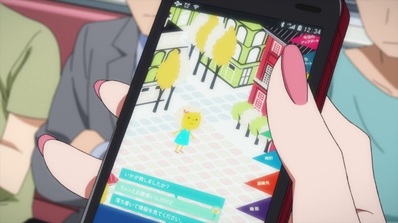
Figure 7
On the surface, the GALAX game adds an element of social or media criticism as in the aforementioned Btooom! because it portrays the potentially dangerous dynamics of gamification. Even though GALAX awards players points for doing good deeds and is effectively used to solve problems that the police and other law enforcement agencies cannot handle within the narrative, it ultimately triggers an exaggerated desire for recognition that has catastrophic consequences. As a remake strategy, however, the fictional game performs two different functions. First, it bridges the thirty-year gap between the original and the remake by integrating a topical aspect of contemporary mainstream media culture. More importantly, it strategically unbalances and remixes the otherwise extremely standardized plot involving a group of superheroes (partially of alien origin) fighting alien invaders on Earth. When the original Gatchaman anime aired, the notion of superheroes had been much less prominent outside of comic books, and the series combined it with popular topics of the time such as environmentalism and a responsible use of technology. The dangers of gamification abuse obviously fit the latter category, but the game and its fictional creator, Rui, primarily represent a third “force” in the plot that serves to complicate the relation between the forces of good (the Gatchaman team) and evil (the shape-shifting alien villain Berg Kattse, which already featured prominently in the original series).
After this preliminary taxonomy of textual relations, the final paragraph will tentatively broaden the scope to include other forms of games such as collectible card games in an attempt to assess the genuinely “digital quality” of video games and its compatibility with anime franchises.
Outlook
The recently intensifying intertextual relations between manga, anime and video games analyzed in this essay pose a number of follow-up questions for further research. First, a close reading of selected examples can provide a more detailed and systematic understanding of the narrative strategies. Furthermore, transmedia relationships between anime franchises and other forms of games such as collectible card games (CCGs) can and should also be considered. Some card games such as Yu-gi Oh! are closely tied to a corresponding anime series, and the fictional characters even mimic the hapticity of playing cards because they actually fight each other using playing cards.
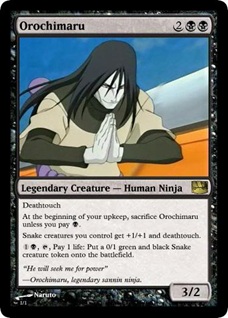
Figure 8
However, many popular shōnen anime series are adapted as CCGs for similar reasons, as in the case of video game adaptations. By quantifying and modularizing characters, props and abilities from anime series like Naruto (Figure 8) or Bleach, these CCGs “teach” players to interpret the original franchise implicitly as games. For example, players extensively compare the most powerful fighting skills33 and discuss which characters would win in one-on-one battles, occasionally even across different franchises. Prominent examples of user-generated content such as custom-designed cards for Magic: The Gathering based on anime characters can similarly be understood as forms of transcoding in the sense of Lev Manovich. The creators of these cards demonstrate a particularly high level of game literacy because they are able to map the implied rule system of the anime and the familiar CCG mechanics of Magic: The Gathering onto each other. Finally, recent examples such as anime adaptations of Western video games like as Dead Space (Electronic Arts, 2008) and Halo (Microsoft Game Studios, 2001)34 suggest that these reciprocal textual relationships can and should also be feasibly addressed from a culturally comparative perspective.
NOTES
- See Theresa Winge, "Costuming the Imagination: Origins of Anime and Manga Cosplay," Mechademia 1, no. 1 (2006), 65-76.
- Mary Flanagan, "Mobile Identities, Digital Stars, and Post-cinematic Selves," Wide Angle 21, no. 1 (1999), 80-82.
- James Verini, "How Virtual Pop Star Hatsune Miku Blew up in Japan," Wired, October 19, 2012, http://www.wired.com/underwire/2012/10/mf-japan-pop-star-hatsune-miku/ (accessed May 9, 2014).
- Martin Picard, "Video Games and their Relationship with Other Media," in Video Game History: From Bouncing Blocks to a Global Industry, ed. Mark J.P. Wolf (Westport, CT: Greenwood Press, forthcoming), 4.
- Dani Cavallaro, Anime and the Visual Novel: Narrative Structure, Design and Play at the Crossroads of Animation and Computer Games (Jefferson, NC: McFarland, 2010), 8.
- See “Lara Croft: Tomb Raider,” Box Office Mojo, http://www.boxofficemojo.com/movies/?id=tombraider.htm (accessed May 9, 2014). The most financially successful video game adaptation was Lara Croft: Tomb Raider (Simon West, 2001), which grossed approximately $270 million worldwide and was surpassed only by Prince of Persia: The Sands of Time (Mike Newell, 2010) almost two decades later.
- Jamie Russell, Generation Xbox: How Videogames Invaded Hollywood (Lewes, East Sussex: Yellow Ant Media Ltd., 2012), 9.
- William Uricchio, "Television, Film and the Struggle for Media Identity," Film History 10, no. 2 (1998): 118-27.
- One prominent example is the game Under a Killing Moon (1994), which draws on elements of the “(sci-fi) noir” style often associated with the medium of film but also emphasizes the “added value” of digital games by focusing on exploration and interactive dialogues that flesh out the colorful characters.
- N. Katherine Hayles, "Print Is Flat, Code Is Deep: The Importance of Media-Specific Analysis," Poetics Today 25, no. 1 (2004): 73.
- See Sword Art Online Wiki, “Color Cursor,“ Wikia, http://swordartonline.wikia.com/wiki/Color_Cursor (accessed May 9, 2014).
- See 9Sun, “More Like Sword Art Online Menu Style by 9Sun,” deviantART, http://www.deviantart.com/morelikethis/341660072 (accessed May 9, 2014). Most notably, the UI syntax is re-constructed in user-created skins for operating systems like Windows and Android or for skinnable tools such as media players. However, the narrative functions of the user interface, such as players finding an unknown item or skill in their virtual inventory, are also occasionally being used in fan fiction stories.
- Mélanie Bourdaa, "‘Following the Pattern’: The Creation of an Encyclopedic Universe with Transmedia Storytelling," Adaptation 6, no. 2 (2013): 206, 211.
- Henry Jenkins, Convergence Culture. Where Old and New Media Collide (New York: New York University Press, 2006), 97.
- Still, many viewers/players do not read the original novels (even though there are usually fan translations), and, after the anime series, the franchise can often evolve into different directions than those mapped out in the books.
- For example, they portray familiar characters in unusual ways or explore their romantic relationships, which are often only hinted at during the main story arcs.
- Clive Thompson, "Turn Left at the Zombie," Slate, September 10, 2004, http://www.slate.com/articles/technology/gaming/2004/09/turn_left_at _the_zombie.html (accessed May 9, 2014).
- Bourdaa, 208.
- Lev Manovich, The Language of New Media (Cambridge, MA: MIT Press, 2001), 63-65.
- Ibid, 49-50.
- See Various, “Main/Console Wars,” Television Tropes & Idioms, http://tvtropes.org/pmwiki/pmwiki.php/Main/ConsoleWars (accessed May 9, 2014).
- Cavallaro, 7
- See Gamerforlife, “Beat’em Ups 101: All You Need to Know About Brawlers,” Rocketboy, August 10, 2010, http://www.racketboy.com/retro/beatemups/beatem-ups-101-all-you-need-to-know-about-brawlers (accessed May 9, 2014). Both genre labels originated in early video game journalism and were gradually adopted into mainstream discourse on video games. They are not, however, very consistently defined and differentiated.
- See Viona Kaleb, “What the Heck with Those Avatars!,“ YouTube, https://www.youtube.com/watch?v=pEWjsjQO9Oo (accessed May 9, 2014).
- The term “manhua” originally referred to a form of Chinese paintings that date back to the 18th century but today commonly describes comics produced in Mainland China, Taiwan and Hong Kong. It later served as a reference point for the Japanese term “manga,” which became popular during the 19th century.
- Anime and manga are among the most prominent examples on websites such as tvtropes.org, which aggregate and channel fan activity.
- The term refers to a series of experiments conducted by Stanley Milgram in the 1960s that demonstrated the considerable willingness of many average participants to accept and obey an authority figure.
- crunchyroll, “Log Horizon and Sword Art Online - similar concept (or not?) Discuss,“ crunchyroll, http://www.crunchyroll.com/forumtopic-807635/log-horizon-and-sword-art-online-similar-concept-or-not-discuss (accessed May 9, 2014). Sites like crunchyroll, one of the most popular online distributors and fan communities for anime content in the US, represent a useful and at least tentatively representative overview of user perceptions regarding conceptual overlaps between game-based anime franchises.
- See MangaReader, “The World God Only Knows 1,“ MangaReader, 37, http://www.mangareader.net/120-5960-37/the-world-god-only-knows/chapter-1.html (accessed May 9, 2014).
- See crunchyroll, “WATAMOTE ~No Matter How I Look at It, It’s You Guys Fault I’m Not Popular,” crunchyroll, http://www.crunchyroll.com/watamote-no-matter-how-i-look-at-it-its-you-guys-fault-im-not-popular (accessed May 9, 2014). The original title of the series is translated as ~No Matter How I Look at It, It's You Guys' Fault I'm Not Popular!~.
- John Seavey, "Storytelling Engines: Introduction," Fraggmented (Weblog of John Seavey), December 18, 2006, http://fraggmented.blogspot.com/2006/12/storytelling-engines-introduction.html (accessed May 9, 2014).
- Jan Simons, “A Critical Mind: The Game of Permanent Crisis Management,” in Mind the Screen: Media Concepts According to Thomas Elsaesser, ed. Jaap Kooijman, Patricia Pisters and Wanda Strauven. (Amsterdam: Amsterdam University Press, 2008), 120-121.
- See Various, "Which is the Most Powerful Ocular Jutsu in Naruto? Sharingan? Byakugan? or Rinnegan?“ Yahoo! Answers, http://answers.yahoo.com/question/index?qid=20110106101511AAlmmoW (accessed May 9, 2014).
- See Damon Guy, “DVD Review: Dead Space: Downfall: An Enjoyable Convergence of Sci-fi and Anime,“ Examiner.com, http://www.examiner.com/review/dvd-review-dead-space-downfall-an-enjoyable-convergence-of-sci-fi-and-anime (accessed May 9, 2014).

Manga, Anime and Video Games: Between Adaptation, Transmedia Extension and Reverse Remediation by Stefan Werning is licensed under a Creative Commons Attribution 4.0 International License

